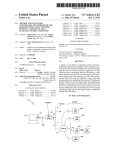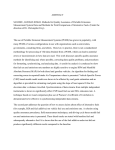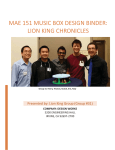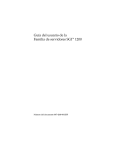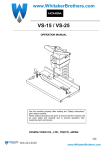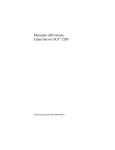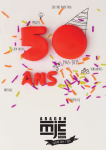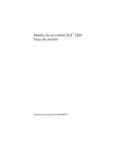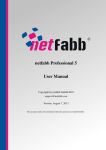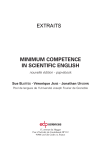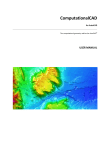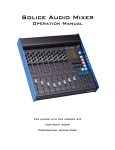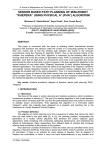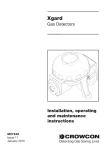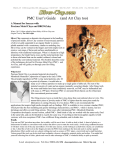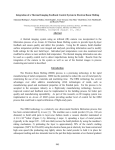Download The Pennsylvania State University The Graduate School
Transcript
The Pennsylvania State University The Graduate School Department of Industrial and Manufacturing Engineering DEVELOPMENT OF A PROCESS PLANNING MODULE FOR LENS ADDITIVE MANUFACTURING A Thesis in Industrial Engineering by Eric W. Chernow © 2013 Eric Chernow Submitted in Partial Fulfillment of the Requirements for the Degree of Master of Science May 2013 ii The thesis of Eric Chernow was reviewed and approved* by the following: Sanjay Joshi Professor of Industrial Engineering Thesis Advisor Timothy W. Simpson Professor of Industrial & Manufacturing Engineering Paul Griffin Professor of Industrial Engineering Head of the Department of Industrial and Manufacturing Engineering * Signatures are on file in the Graduate School iii ABSTRACT Producing metallic parts using Laser Engineered Net Shaping (LENS) additive manufacturing allows for a wide range of flexibility and customization while reducing waste material compared to traditional methods. One of the important aspects of additive manufacturing is process planning, and there are many decisions that must be made in order to convert a CAD representation of a desired component into a finished part. These include determining the build orientation, generating support structures for necessary areas, slicing the model, and creating the toolpath that the machine will follow. The interdependence of these tasks is complex; so, traditional methods that only consider individual parameters result in an inferior end product. This thesis introduces a framework to determine optimal settings and parameters for metal additive manufacturing. It outlines a series of steps to reduce build time and cost while ensuring high quality components. The relationships between various parameters are addressed. Commercial software packages are examined for usability and value in the process planning methodology. The thesis concludes with suggestions for further research and experiments to understand the relationships between process parameters for LENS systems. iv TABLE OF CONTENTS LIST OF FIGURES…………………………………………………………...…………… v LIST OF TABLES …………………………………………………….………………...… vi ACKNOWLEDGEMENTS………………………………………………………………... vii Chapter 1 Introduction……………………………………….……………………………. 1 1.1 Motivation……………………………………………………………………… 1 1.2 Scope…………………………………………………………………………… 1 1.3 Objectives……………………………………………………………………… 2 1.4 Organization……………………………………………………………………. 2 Chapter 2 Literature Review………………………………………………………………. 4 2.1 Additive Manufacturing Overview…………………………………………….. 4 2.2 LENS Process Overview………………………………………………………..5 2.3 Process Planning Overview……………………………………………………. 5 Chapter 3 Process Planning Framework…………………………………………………... 7 3.1 Introduction…………………………………………………………………….. 7 3.2 Problem Overview……………………………………………………………... 8 3.3 Parameter Framework………………………………………………………….. 10 3.4 Software Comparison…………………………………………………………...14 Chapter 4 Parameter Relationship Analysis………………………………………………. 4.1 Introduction…………………………………………………………………….. 4.2 Experimental Design…………………………………………………………… 4.3 Results………………………………………………………………………….. 4.4 Analysis of Results…………………………………………………………….. Chapter 5 Process Planning Module………………………………………………………. 5.1 Inputs to Module……………………………………………………………….. 5.2 Module Interface……………………………………………………………….. 5.3 Outputs of Module……………………………………………………………... 5.4 Sample Part…………………………………………………………………….. Chapter 6 Conclusions and Future Research……………………………………………… REFERENCES…………………………………………………………………………….. 17 APPENDIX – Collected Data from Parameter Experiment……………………..………… v LIST OF FIGURES Figure 1: LENS Powder Delivery System (adopted from Keicher et al., 1997)….…….…. 8 Figure 2: LENS CAD Design to Finished Part Flowchart………………………………….9 Figure 3: Hatch Angle and Hatch Width…………………………………………………... 13 vi LIST OF TABLES Table 1: Additive Manufacturing Process Parameter Framework for LENS Systems….…. 11 vii ACKNOWLEDGEMENTS I would like to thank Dr. Sanjay Joshi for his help in the project. It has been a fantastic experience getting to know him over the past two years and his mentoring and advice has proven invaluable in knocking down obstacles in my way. In addition, I would like to thank Dr. Timothy W. Simpson for the input throughout the project and always challenging me to take the research to the next level. Additionally, I received great support from this project from the Applied Research Lab at Penn State, including Dr. Richard Martukanitz and Dr. Ted Reutzel. They have been excellent advisors in placing me in contact with industry leaders and allowing access to the additive manufacturing machinery. Finally, I would like to thank my family for always encouraging me to strive for the best and persevere, and my friends for helping me remember to have fun. 1 Chapter 1 Introduction 1.1 Motivation This research is motivated by a growing interest in advanced manufacturing techniques, such as additive manufacturing. Due to companies outsourcing various industries and jobs to other countries, the government has been tasked in the development of these new procedures in order to differentiate the United States in the manufacturing sector. When used properly, additive manufacturing provides the ability to produce near-net shapes that are impossible to create using traditional manufacturing. Although there is great interest in advancing the technique, because it is so new there has been very little research done into optimal parameters and settings for these machines. Additionally, there has been no comprehensive study as to the relationships between the various parameters or the establishment of a processing planning module to bring together simulation and production of the final parts. 1.2 Scope The Applied Research Lab at Penn State has established a research facility under DARPA at Innovation Park consisting of numerous additive manufacturing machines. One of these machines is the Optomec LENS MR-7, which is the major focus of this thesis. Although the procedure and experiments explained can relate to almost any additive manufacturing process, the results that are obtained from the experimentation portion are specific towards this machine. The process planning module that is established can also be 2 used for any process, as long as the design rules are changed and the proper optimal values and experimentation are done. 1.3 Objectives The goal of the research is to analyze the processing planning functions that would allow for successful integration with design, simulation, and subsequent manufacturing. For example, given a process and part model, material properties, and final product characteristic, the build microstructure and layer dimensions can be decided. The strength and mechanical properties can also be related to other attributes such as build geometry, layer thickness, layer orientation, and support structures. The process planning module will involve such activities as build geometry, layer thickness, layer orientation, and support structures. In order to determine optimal parameters for these activities, experimentation will be done on numerous process parameters to demonstrate the relationships between them. A final grouping of experiments will be suggested to further explore some of these parameters. 1.4 Organization Chapter 2 provides a look into the relevant literature in the area of additive manufacturing. This includes an overview of all additive manufacturing processes and the establishment of the technique, how the Optomec LENS process has been used in industry and the various fields it has been present in, and processing planning among additive manufacturing machines. Chapter 3 examines the flowchart from CAD design to final part, the key processing parameters in LENS additive manufacturing, and the need to establish a relationship between these parameters. The various choices of software for the process are also evaluated. Chapter 4 is the results of an experiment between the hatch spacing, laser 3 power, and powder flow rate in single layer parts and the analysis of the layer thickness of these parts. Chapter 5 is the fully explained process planning module, including the inputs and outputs of the module itself. It also shows a sample part going through the entire process and being evaluated for problems, and then being corrected. Chapter 6 has conclusions of the thesis and areas for future research. 4 Chapter 2 Literature Review 2.1 Additive Manufacturing Overview There has been much progress in additive manufacturing since its introduction to industrial applications over two decades ago. The technology developed from the desire to directly fabricate polymers at the intersection of two laser beams, and was transposed into using metal powders by Ciraud in 1971 [1]. This research was further extended by Housholder in 1979, who patented a powder laser sintering process in which each of the layers could be solidified selectively [1]. As the processes began to mature, new layered manufacturing developers began to see opportunities for the processes to be used in industrial settings. This caused different technologies to emerge such as fused deposition modeling, selective laser sintering, and 3D printing. All differ in the materials that can be used, the geometry that can be processed, and the strength obtained from the final products [2]. A distinction has also begun to emerge between those machines that are purely concept modelers for design verification, those that are used for rapid prototyping and rapid tooling, and those used for rapid manufacturing [2]. Since 1991, very few new rapid prototyping processes have been developed and much of the research has been spent improving those current methods [3]. Specifically, a drastic increase in speed and introduction of new materials allows these machines to be used in manufacturing processes around the world to produce complex parts [3]. The laser engineered net shaping (LENS) process was commercialized by Optomec in 1997 to fabricate parts made from titanium alloys and steel and has been in use in companies around the world such as Aeromet, which creates complex 5 parts for aerospace applications [5]. Although the machines have strict restrictions with overhang angles due to a lack of powder, it was found that depositing support material was a successful alternative and serves the same purpose [4]. 2.2 LENS Process Overview Applications of additive manufacturing in LENS are widespread, and can be found in many different industries. The aerospace field has used AM to produce parts for NASA and jet engine fan blades [5]. Heavy usage in the military sector is predicted in the future, but mostly in lower volume and complex parts because AM cannot compete economically with large-scale casting and molding [6]. The technology has also seen great use in the health care industry to create complex metal designs. The Walter Reed National Military Medical Center has used AM to make cranial plates and cutting guides for bone grafts that are a better fit with patients than traditional designs [7]. Electron beam melting has been used to create hip implant components [7]. A survey found that build speed and surface roughness ranked in the top three most important aspects for improvement across four of the six AM technologies that build metal parts [5]. The same survey found that in-process monitoring was ranked in the bottom half in five out of the six technologies, and raw material variety was not placed high on the list of priorities of aspects needing improvement [5]. 2.3 Process Planning Overview The research into the tasks to convert a CAD model into a finished product using additive manufacturing machines is collectively referred to as process planning. The four major steps in process planning have been defined as slicing, orientation determination, support generation, and path planning [8]. Individual studies have been done in each of these 6 steps, such as using an expert-systems based approach to determine optimal build direction based on the user’s input and a decision matrix [9]. Additionally, the interface between the CAD design and these systems is a key component in determining the final quality of part. The STL (STereoLithography) format is the most prevalent input to an additive manufacturing process planning system, and it treats the CAD model as a series of triangular facets [10]. The tessellated design was found to be not as robust as other file types, and the suggestion was made to move to a new file type to enable precise modeling in these additive manufacturing designs [10]. Although not mentioned, the inferior STL file type is utilized by the LENS machine. This highlights how process planning techniques have not been directly applied to the LENS system, nor has a framework with a list of steps to follow been developed. The interdependence between the process planning tasks is also mentioned as an item of future interest by many researchers [8], but no formal system has been developed to date. 7 Chapter 3 Process Parameter Framework 3.1 Introduction Metal additive manufacturing is the process of building a three-dimensional (3D) part in a layer by layer fashion. The process specifically for Optomec’s LENS MR-7 laser-based direct digital manufacturing system starts with a 3D CAD file which is sliced into layers by one of various computer programs. A toolpath is generated for each layer outputting code for the machine to use as instructions on how to build the desired part. The material fed into the machine is fine particles or powder on the scale of nanometers. The powder is pumped out of four nozzles directly under a laser that has a maximum of 500 W and sinters the powder together on the metal substrate that moves in the x and y directions as determined by the toolpath. Once the first layer has finished printing, the laser and nozzle move in the z direction the distance equivalent to one layer of printed material and the second layer begins to be printed. This activity takes place in an environmentally controlled chamber maintaining oxygen at less than 10 parts per million which is optimal for the sintering process. After the final layer is printed and the part is removed from the substrate, the output is ideally a part consistent with the original 3D design. Figure 1 labels the major portions of the powder delivery system [11]. 8 Figure 1: LENS Powder Delivery System (adopted from Ketcher et. al., 1997) This unique manufacturing process is used for prototyping, repairs, creating complex parts, artwork and many other projects since it has such a wide range of capabilities and enables the designer to be much more creative than traditional processes [11]. Although the process begins with a CAD file, the operations done to convert that file into a finished design are quite complex and not well understood. There are many parameters that need to be established including settings on the machine, the material properties, the way that the file is sliced, and the toolpath options. 3.2 Problem Overview When creating a 3D part from a CAD file, there are many steps that need to be completed, each with its own options that need to be chosen. In order for the output to successfully be the desired 3D part, the flow from design to part and the choices to be made in each step need to be fully understood. Otherwise, one small error at any step could make a finished part far from satisfactory. A part begins as a CAD file in STL file format. Once the desired material is selected, the STL file is sliced into individual layers to be printed one at a time. In order to do this, a slicing software package needs to be selected and used. Since different packages have 9 different capabilities and compatibilities with machines, this choice is quite important. The selected machine also has its own settings which must be chosen including the speed at which the machine prints, the laser power, and the rate at which the material is deposited. When slicing the file, the desired build orientation and the layer thickness need to be chosen because the output of the slicing step is a SLI file. Next, a toolpath for each layer needs to be generated by the software. This step contains many decisions in order to create the desired part; such as the algorithm chosen for the direction of the toolpath (spiraling in towards the center, linear patterns, etc.), the spacing between each line of the toolpath (hatch spacing), if the outer contour of the toolpath will be thicker than the inside, and many other options. The output of the toolpath generation step for a LENS system is a DMC file called the DMC code. Once all of these choices are made, the file is uploaded to the LENS system. The following CAD design to finished part flowchart shows the major steps in the process. Figure 2: LENS CAD Design to Finished Part Flowchart 10 There are many choices and settings which must be determined in order to use metal additive manufacturing machines such as the LENS. In order to make these decisions not only does the flow of information from CAD design to finished part need to be understood, but how the parameters which are chosen affect the output need to be known as well. These parameters not only change the final product, but they affect each other as well. Without proper knowledge of the relationships between parameters and their effects on the part, a successful output cannot be created. Therefore, a detailed framework needs to be created to determine optimal settings and parameters for metal additive manufacturing to be an effective tool. 3.3 Parameter Framework There are many parameters that need to be defined in order to follow the flowchart described in the previous section and obtain the desired outputs. A comprehensive framework was created to detail each of the settings that need to be entered so that a metallic part can be produced, as well as classifying each of those decisions into various stages [6]. Table 1 shows this framework on the next page, which is elaborated in detail in the following sections. 11 Table 1: Additive Manufacturing Process Parameter Framework for LENS Systems The material parameters should be the first to be defined, since the CAD design has presumably been created with a typical material in mind. It is necessary to determine the particle size and the alloy type of the metal to be used, since different metals have different properties and produce varying results depending on many of the other options selected. The machine parameters would be the next options to be chosen. The laser beam power is the maximum power that the laser will achieve during the operation of the machine. The travel speed determines how fast the laser head will move during the operation of the machine. The deposition rate is set depending on the velocity that the user would like the powder to move from the powder feeder through the powder nozzle. The gas chamber 12 settings (e.g., oxygen and moisture levels) are set and adjusted by the influx of argon, which prevents oxidation. There are many additional considerations that need to be made when selecting an orientation for a part to be produced. The most important is the height in the build direction, as this has a direct impact on the length of time it will take to make the part. Related to this is the volume of support structure that would need to be used in order to produce a part in this orientation. Other decisions that must be made revolve around the quality of surface that is desired, and the area of the base on which the part will be built. The base must be larger than the first layer of the selected orientation, and therefore the selected base and the build envelope itself could limit the orientation options. The distortion or curl produced in the part should also be taken into account, as it could cause parts to be out of tolerance if not addressed. Once the orientation has been selected, it is possible that some of the features in the part would require supports. This could include things like overhangs and holes in the part. In a LENS benchmarking experiment, it was found that an angle of approximately 26 degrees was the largest that the researchers could achieve without the use of support structures [12]. If support structures are used then the shape of those structures must be selected as well as the size of the pillars and the distance between successive supports. Slicing options involve the segmentation of the CAD file into stacked slices, which will be produced by the machine one layer at a time. These slices could be a variable layer thickness in which both the maximum and minimum allowable would need to be set, as well as the algorithm to be used to determine the individual slices. Alternatively, the layers could 13 be a single fixed thickness which would not change in the part. The hatch width would be the distance between successive hatches in the production, while the different hatch styles refer to the different ways that the hatches can be deposited. Hatch angles must be set if successive hatches are to be done at differing slopes. Figure 3 shows the key hatching parameters on an example layer. Figure 3: Hatch Angle and Hatch Width The final set of parameters relate to toolpath generation. The number of contours for each layer can be defined at this stage, as well as the start location for each of the layers. For many parts, starting at the same location for every layer presents some difficulties; so, either a random location can be selected or a small move can be made on the contour so that a different spot is chosen. The toolpath algorithm can also be selected to determine which one of the hatches is constructed first, and how the program will progress from one hatch to another. Additionally, there are options dealing with disconnected hatches due to holes and “blocking” groups of similar hatches together. One of the major issues is the interactions between the previously defined process parameters. Quite often, changing one parameter will necessitate a change in another in order to produce a consistent part. For example, if the travel speed is increased but the laser beam power remains the same, then powder might not melt correctly, and any additional layers would fail to be deposited. For this reason, the interdependence between the tasks is of great interest to researchers. Determining optimal values for individual parameters without taking into account how they affect others will yield poor designs. Therefore, experiments to 14 determine settings should incorporate multiple parameters in an attempt to find the best combinations to produce consistent results. 3.4 Software Comparison There are numerous commercial software packages that allow many of these parameters to be chosen during the conversion process from the STL file to the DMC code. However, each one has slightly different settings and customization options that allow the user more options for process planning. The following section details some of the packages available as well as their strengths and weaknesses in the overall process planning methodology. PartPrep is the program suggested by Optomec to be used with the LENS machine, and presents the least issues in terms of compatibility. It is also quite simplistic in its design and is the easiest to use to begin producing parts quickly. Unfortunately, it also presents the least options for customization and does not allow for variable slice thicknesses, as one value must be selected for each of the slices in the SLI file. The distance and angle for up to six different hatches can be defined by the user, but there is no assistance by the software to choose any optimal settings for these values. There are only two different choices for defining the toolpath and contours, although it can be selected that each layer begins in a different spot on the contour. It also offers the option of predicting how long the build will take based on the values entered by the user and its calculated path [13]. Compared with PartPrep, VisCAM 4.0 has many more options for users in terms of customization. The program allows changes of the part orientation directly by using options such as the least height or the highest mass on the bottom. It will automatically generate 15 supports when the proper settings are entered, which is a very useful feature to have since otherwise it would be necessary to alter the CAD file after the orientation step. The program can account for distortion using its shrinkage compensation feature, which is calculated based on the type of material that is entered. It can also vary the slice thicknesses by using the maximum and minimum entered. It can predict the total cost of producing a part when information is entered by the user. Some of the hatching options are a bit lacking, as only a single defined angle can be entered and layers are differentiated using that angle. Although LENS does not directly support the program, there have not been many issues in using it to create SLI files [14]. Netfabb strikes a middle ground between options and ease of use. It allows for the distance and angle of the hatching to change between layer, and users can completely customize every layer if they so desire. It also allows variable slice thicknesses to be selected, and combining these two options creates the most customizable slicing package available. Unfortunately, it falls behind in other key areas. It does not allow for supports to be generated or for shrinkage to be taken into account. There are no prediction parameters included with the program, which does not allow a user to determine whether one group of settings would be preferable over others based on time or cost. A major disadvantage is that the package is not currently supported by LENS, but this might change in the future [15]. Magics provides the best package out of those that Optomec claims is fully compatible with LENS. The program allows for supports to be generated, and shrinkage is taken into account via a multiplicative factor entered by the user. Variable slicing thicknesses are supported, and the prediction parameters can take both time and cost into account. It does lack a bit in the hatching options, since the layers are only allowed to be 16 alternated by 90 degrees every time. In this way, completely perpendicular hatches must be created in successive layers, and there is no option to change this. However, the program is more robust then PartPrep and should be the dedicated software for those users who wish to have the most process planning options immediately after the machine is operational [16]. There are some features that are believed to be useful that do not appear in any of the commercial packages. Having the ability to set a pause time between various layers would allow for cooling to occur and would drastically increase the range of parts that could be produced. The programs are also limited in the options that each present in dealing with multiple powders fed into the system at the same time. Since LENS systems tend to have two powder feeders, these should be able to work concurrently not only in an individual layer but also in creating a gradient in the x-y direction. Currently, any modifications such as these must be made directly to the DMC code after generation, which is a tedious process. 17 References [1] Bourell, D.L., Beaman, J.B., Leu, M.C. and Rosen, D.W., 2009, "A Brief History of Additive Manufacturing and the 2009 Roadmap for Additive Manufacturing: Looking Back and Looking Ahead," RapidTech: US-Turkey Workshop on Rapid Technologies. [2] Levy, G.N., Schindel, R., and Kruth, J.P., 2003, "Rapid Manufacturing and Rapid Tooling with Layer Manufacturing (LM) Technologies, State of the Art and Future Perspectives," CIRP Annals - Manufacturing Technology, 52(2), 589-609. [3] Kruth, J., Leu, M., and Nakagawa, T., 1998, "Progress in Additive Manufacturing and Rapid Prototyping," CIRP Annals - Manufacturing Technology, 47(2), 525-540. [4] Santos, E., Shiomi, M., Osakada, K., and Laoui, T., 2006, "Rapid Manufacturing of Metal Components by Laser Forming." International Journal of Machine Tools and Manufacture, 46(12-13), 1459-1468. [5] Hartke, K., 2011, "Manufacturing Technology Support (MATES). Task Order 0021: Air Force Technology and Industrial Base Research and Analysis, Subtask Order 06: Direct Digital Manufacturing," Air Force Research Laboratory Materials and Manufacturing Directorate, 1-94. [6] Shipp, S., et. al., 2012, "Emerging Global Trends in Advanced Manufacturing," Institute for Defense Analyses, 1-75. [7] Scott, J., et. al., 2012, "Additive Manufacturing: Status and Opportunities," Science and Technology Policy Institute, 1-29. 18 [8] Kulkarni, P., Marsan, A., and Dutta, D., 2000, "A Review of Process Planning Techniques in Layered Manufacturing," Rapid Prototyping Journal, 6(1), 18-35. [9] Frank, D., and Fadel, G., 1995, "Expert System-based Selection of the Preferred Direction of Build for Rapid Prototyping Processes," Journal of Intelligent Manufacturing, 6(5), 339-345. [10] Kai, C.C., Jacob, G.G.K., and Mei, T., 1997, "Interface between CAD and Rapid Prototyping Systems. Part 1: A Study of Existing Interfaces," The International Journal of Advanced Manufacturing Technology, 13(8), 566-570. [11] Keicher, D.M., Smugeresky, J.E., Romero, J.A., Griffith, M.L., and Harwell, L.D., 1997, "Using the Layer Engineered Net Shaping (LENS) Process to Produce Complex Components from a CAD Solid Model," Proc. of SPIE, 2993, 91-97. [12] Brezocnik, M., Lestan, Z., Stepisnik, S., and Milfelner, M., 2010, "The Use of LENS Technology for Producing Implants," Trends in the Development of Machinery and Associated Technology, 625-628. [13] Optomec, 2009, "LENS MR-7 System Manual." [14] Marcam Engineering, 2008, "VisCAM RP 4.0 User Manual." [15] netfabb GmbH, 2011, "netfabb Studio Professional 4 User Manual." [16] Materialise Software, 2008, "Magics Envisiontec (Version 9.1)."

























